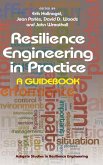For Resilience Engineering, 'failure' is the result of the adaptations necessary to cope with the complexity of the real world, rather than a breakdown or malfunction. The performance of individuals and organizations must continually adjust to current conditions and, because resources and time are finite, such adjustments are always approximate. This definitive new book explores this groundbreaking new development in safety and risk management, where 'success' is based on the ability of organizations, groups and individuals to anticipate the changing shape of risk before failures and harm occur. Featuring contributions from many of the worlds leading figures in the fields of human factors and safety, Resilience Engineering provides thought-provoking insights into system safety as an aggregate of its various components, subsystems, software, organizations, human behaviours, and the way in which they interact. The book provides an introduction to Resilience Engineering of systems, covering both the theoretical and practical aspects. It is written for those responsible for system safety on managerial or operational levels alike, including safety managers and engineers (line and maintenance), security experts, risk and safety consultants, human factors professionals and accident investigators.
'This is the most thought-provoking collection of papers I've read in a very long time. They are written by the best in the field at the top of their form. Resilience is a notion whose time has come. We cannot realistically expect to eliminate adverse events and still stay in business. But we can strive to achieve greater robustness towards our operational hazards. This book tells us how to do it and why it's necessary.' James Reason 'This book is the next frontier for improving safety in healthcare, aviation, nuclear power and other high technology systems. Innovative and intellectually challenging, Resilience Engineering emphasises the importance of learning about the positive side of safety management; focusing on how frontline staff foresee, adapt and recover from problems. It is an essential read for managers, regulators, academics and operators alike.' Jane Carthey, National Patient Safety Agency in England and Wales, UK 'From my point of view the main achievement of the book is that it provides a turn in the perspective on system safety, from a mainly reactive "hindsight" perspective reflected in the numerous attempts to learn from events and accidents to a more proactive one focusing on the interrelation of safety and the characteristics of organizations as dynamic systems. Although I would hesitate to share the view of Dave Woods that this already represents a paradigm shift in safety research, I am at least convinced that the views and ideas presented in the book provide very important contributions to the understanding of high reliability organizations.' Human Factors and Ergonomics Society Newsletter. 2006 Featured in list 'Selected Works on Resilience, 2001-12' in Chronicle of Higher Education's The Chronicle Review, May 10, 2013








